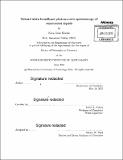| dc.contributor.advisor | Keith A. Nelson. | en_US |
| dc.contributor.author | Manke, Kara Jean | en_US |
| dc.contributor.other | Massachusetts Institute of Technology. Department of Chemistry. | en_US |
| dc.date.accessioned | 2015-09-17T19:12:15Z | |
| dc.date.available | 2015-09-17T19:12:15Z | |
| dc.date.copyright | 2015 | en_US |
| dc.date.issued | 2015 | en_US |
| dc.identifier.uri | http://hdl.handle.net/1721.1/98789 | |
| dc.description | Thesis: Ph. D., Massachusetts Institute of Technology, Department of Chemistry, 2015. | en_US |
| dc.description | Cataloged from PDF version of thesis. | en_US |
| dc.description | Includes bibliographical references (pages 163-176). | en_US |
| dc.description.abstract | Theoretical understanding of the dramatic slow-down of structural relaxation dynamics in supercooled liquids leading to the glass transition is limited in part by the lack of data in these systems. Between the melting point and the glass transition, the viscosity of supercooled liquids can change by 16 orders of magnitude or more and few experimental techniques can access this broad a range of frequencies and time scales. Photoacoustic spectroscopy is an ideal technique for probing the dynamics of supercooled liquids because it provides direct access to mechanical relaxation. Currently, photoacoustic spectroscopy of supercooled liquids has been carried out in the range of 10 MHz to 1 GHz with impulsive stimulated light scattering (ISS) and 8 GHz to 200 GHz with picosecond ultrasonics. In this work, I present advances in photoacoustic techniques with the goal of extending the range of frequencies accessible by these methods. To achieve higher-frequency acoustic generation, experiments on semiconductor superlattices (SLs) composed of alternating layers of gallium arsenide (GaAs) and aluminum arsenide (AlAs) and multiple quantum well structures (MQW) of indium gallium nitride (InGaN) and gallium nitride (GaN) as photoacoustic transducers are presented. The results demonstrate that InGaN/GaN SLs can be employed as broadband photoacoustic transducers, generating acoustic frequencies up to 2.5 THz. A simple transient reflectivity technique for the detection and reconstruction of short (- 2 ps) acoustic strain pulses is also presented. Using a time-domain analogue of Brillouin light scattering, data on the acoustic velocity and attenuation rate of supercooled liquid DC704 at frequencies of - 6 GHz and - 12 GHz, a region which can be hard to access with both ISS and PU approaches, is shown. Finally, the slow rise or "Mountain mode" component of ISS signal from DC704, which arises from slow components of the density response at timescales from 10- 4 s to 10- 7 s is examined. Comparison with the broadband compliance spectrum of DC704 demonstrates that the slow rise signal does not directly reflect the relaxing elastic compliance, but contains contributions from other slow degrees of freedom that couple to the density. | en_US |
| dc.description.statementofresponsibility | by Kara Jean Manke. | en_US |
| dc.format.extent | pages | en_US |
| dc.language.iso | eng | en_US |
| dc.publisher | Massachusetts Institute of Technology | en_US |
| dc.rights | M.I.T. theses are protected by copyright. They may be viewed from this source for any purpose, but reproduction or distribution in any format is prohibited without written permission. See provided URL for inquiries about permission. | en_US |
| dc.rights.uri | http://dspace.mit.edu/handle/1721.1/7582 | en_US |
| dc.subject | Chemistry. | en_US |
| dc.title | Toward ultra-broadband photoacoustic spectroscopy of supercooled liquids | en_US |
| dc.type | Thesis | en_US |
| dc.description.degree | Ph. D. | en_US |
| dc.contributor.department | Massachusetts Institute of Technology. Department of Chemistry | |
| dc.identifier.oclc | 921142480 | en_US |
